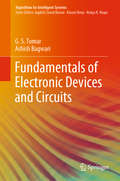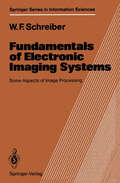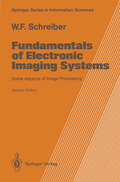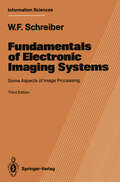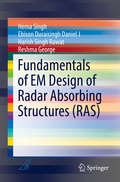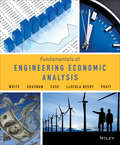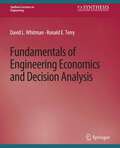- Table View
- List View
Fundamentals of Electroceramics: Materials, Devices, and Applications
by R. K. PandeyThe first textbook to provide in-depth treatment of electroceramics with emphasis on applications in microelectronics, magneto-electronics, spintronics, energy storage and harvesting, sensors and detectors, magnetics, and in electro-optics and acousto-optics Electroceramics is a class of ceramic materials used primarily for their electrical properties. This book covers the important topics relevant to this growing field and places great emphasis on devices and applications. It provides sufficient background in theory and mathematics so that readers can gain insight into phenomena that are unique to electroceramics. Each chapter has its own brief introduction with an explanation of how the said content impacts technology. Multiple examples are provided to reinforce the content as well as numerous end-of-chapter problems for students to solve and learn. The book also includes suggestions for advanced study and key words relevant to each chapter. Fundamentals of Electroceramics: Materials, Devices and Applications offers eleven chapters covering: 1.Nature and types of solid materials; 2. Processing of Materials; 3. Methods for Materials Characterization; 4. Binding Forces in Solids and Essential Elements of Crystallography; 5. Dominant Forces and Effects in Electroceramics; 6. Coupled Nonlinear Effects in Electroceramics; 7. Elements of Semiconductor; 8. Electroceramic Semiconductor Devices; 9. Electroceramics and Green Energy; 10.Electroceramic Magnetics; and 11. Electro-optics and Acousto-optics. Provides an in-depth treatment of electroceramics with the emphasis on fundamental theoretical concepts, devices, and applications with focus on non-linear dielectrics Emphasizes applications in microelectronics, magneto-electronics, spintronics, energy storage and harvesting, sensors and detectors, magnetics and in electro-optics and acousto-optics Introductory textbook for students to learn and make an impact on technology Motivates students to get interested in research on various aspects of electroceramics at undergraduate and graduate levels leading to a challenging career path. Includes examples and problem questions within every chapter that prepare students well for independent thinking and learning. Fundamentals of Electroceramics: Materials, Devices and Applications is an invaluable academic textbook that will benefit all students, professors, researchers, scientists, engineers, and teachers of ceramic engineering, electrical engineering, applied physics, materials science, and engineering.
Fundamentals of Electroceramics: Materials, Devices, and Applications
by R. K. PandeyThe first textbook to provide in-depth treatment of electroceramics with emphasis on applications in microelectronics, magneto-electronics, spintronics, energy storage and harvesting, sensors and detectors, magnetics, and in electro-optics and acousto-optics Electroceramics is a class of ceramic materials used primarily for their electrical properties. This book covers the important topics relevant to this growing field and places great emphasis on devices and applications. It provides sufficient background in theory and mathematics so that readers can gain insight into phenomena that are unique to electroceramics. Each chapter has its own brief introduction with an explanation of how the said content impacts technology. Multiple examples are provided to reinforce the content as well as numerous end-of-chapter problems for students to solve and learn. The book also includes suggestions for advanced study and key words relevant to each chapter. Fundamentals of Electroceramics: Materials, Devices and Applications offers eleven chapters covering: 1.Nature and types of solid materials; 2. Processing of Materials; 3. Methods for Materials Characterization; 4. Binding Forces in Solids and Essential Elements of Crystallography; 5. Dominant Forces and Effects in Electroceramics; 6. Coupled Nonlinear Effects in Electroceramics; 7. Elements of Semiconductor; 8. Electroceramic Semiconductor Devices; 9. Electroceramics and Green Energy; 10.Electroceramic Magnetics; and 11. Electro-optics and Acousto-optics. Provides an in-depth treatment of electroceramics with the emphasis on fundamental theoretical concepts, devices, and applications with focus on non-linear dielectrics Emphasizes applications in microelectronics, magneto-electronics, spintronics, energy storage and harvesting, sensors and detectors, magnetics and in electro-optics and acousto-optics Introductory textbook for students to learn and make an impact on technology Motivates students to get interested in research on various aspects of electroceramics at undergraduate and graduate levels leading to a challenging career path. Includes examples and problem questions within every chapter that prepare students well for independent thinking and learning. Fundamentals of Electroceramics: Materials, Devices and Applications is an invaluable academic textbook that will benefit all students, professors, researchers, scientists, engineers, and teachers of ceramic engineering, electrical engineering, applied physics, materials science, and engineering.
Fundamentals of Electroheat: Electrical Technologies for Process Heating
by Sergio LupiThis book provides a comprehensive overview of the main electrical technologies for process heating, which tend to be treated separately in specialized books. Individual chapters focus on heat transfer, electromagnetic fields in electro-technologies, arc furnaces, resistance furnaces, direct resistance heating, induction heating, and high-frequency and microwave heating. The author highlights those topics of greatest relevance to a wide-ranging teaching program, and at the same time offer a detailed review of the main applications of the various technologies. The content represents a synthesis of the extensive knowledge and experience that the author has accumulated while researching and teaching at the University of Padua’s Engineering Faculty. This text on industrial electroheating technologies is a valuable resource not only for students of industrial, electrical, chemical, and material science engineering, but also for engineers, technicians and others involved in the application of electroheating and energy-efficient industrial processes.
Fundamentals of Electromagnetics: 1Internal Behavior of Lumped Elements (Synthesis Lectures on Computational Electromagnetics)
by David VoltmerThis book is the first of two volumes which have been created to provide an understanding of the basic principles and applications of electromagnetic fields for electrical engineering students. Fundamentals of Electromagnetics Vol 1: Internal Behavior of Lumped Elements focuses upon the DC and low-frequency behavior of electromagnetic fields within lumped elements. The properties of electromagnetic fields provide the basis for predicting the terminal characteristics of resistors, capacitors, and inductors. The properties of magnetic circuits are included as well. For slightly higher frequencies for which the lumped elements are a significant fraction of a wavelength in size the second volume of this set, Fundamentals of Electromagnetics Vol 2: Quasistatics and Waves, examines how the low-frequency models of lumped elements are modified to include parasitic elements. Upon completion of understanding the two volumes of this book, students will have gained the necessary knowledge to progress to advanced studies of electromagnetics.
Fundamentals of Electromagnetics 2: Quasistatics and Waves (Synthesis Lectures on Computational Electromagnetics)
by David VoltmerThis book is the second of two volumes which have been created to provide an understanding of the basic principles and applications of electromagnetic fields for electrical engineering students. Fundamentals of Electromagnetics Vol 2: Quasistatics and Waves examines how the low-frequency models of lumped elements are modified to include parasitic elements. For even higher frequencies, wave behavior in space and on transmission lines is explained. Finally, the textbook concludes with details of transmission line properties and applications. Upon completion of this book and its companion Fundamentals of Electromagnetics Vol 1: Internal Behavior of Lumped Elements, with a focus on the DC and low-frequency behavior of electromagnetic fields within lumped elements, students will have gained the necessary knowledge to progress to advanced studies of electromagnetics.
Fundamentals of Electromagnetism: Vacuum Electrodynamics, Media, and Relativity
by Arturo López Dávalos Damian ZanetteThis textbook is a revised and enlarged version of notes for a one-semester course on electromagnetism. It covers the theory of electromagnetic phenomena in vacuum and in material media. The book includes a CD-ROM with didactic software, to solve boundary value problems in electrostatics and magnetostatics.
Fundamentals of Electromigration-Aware Integrated Circuit Design
by Jens Lienig Matthias ThieleThe book provides a comprehensive overview of electromigration and its effects on the reliability of electronic circuits. It introduces the physical process of electromigration, which gives the reader the requisite understanding and knowledge for adopting appropriate counter measures. A comprehensive set of options is presented for modifying the present IC design methodology to prevent electromigration. Finally, the authors show how specific effects can be exploited in present and future technologies to reduce electromigration’s negative impact on circuit reliability.
Fundamentals of Electronic Devices and Circuits (Algorithms for Intelligent Systems)
by G.S. Tomar Ashish BagwariThis book focuses on conceptual frameworks that are helpful in understanding the basics of electronics – what the feedback system is, the principle of an oscillator, the operational working of an amplifier, and other relevant topics. It also provides an overview of the technologies supporting electronic systems, like OP-AMP, transistor, filter, ICs, and diodes. It consists of seven chapters, written in an easy and understandable language, and featuring relevant block diagrams, circuit diagrams, valuable and interesting solved examples, and important test questions. Further, the book includes up-to-date illustrations, exercises, and numerous worked examples to illustrate the theory and to demonstrate their use in practical designs.
Fundamentals of Electronic Imaging Systems: Some Aspects of Image Processing (Springer Series in Information Sciences #15)
by William F. SchreiberImage processing is an applications area. In this area there are many op portunities to apply art and experience, as well as knowledge from various sciences and engineering disciplines, to the creation of products and pro cesses for which society has urgent need. Without this need, few would be interested in the subject. This point of view motivates this work and has influenced the selection and treatment of topics. It will be noticed that the word "digital" is not in the title. While much of present-day image processing is implemented digitally, this work is not intended for those who think that image processing is a branch of digital signal processing, except perhaps to try to change their minds. This book grew out of courses taught at the Massachusetts Institute of Technology by the author and two of his former students, T.S. Huang and O.J. Tretiak. Like the courses, it is primarily intended for electrical engineers and computer scientists who plan to work in the field. It has not proven necessary to spend much time on strictly digital issues, since the students either know that material already or can learn it very easily by 1 themselves. It also has been unnecessary to be encyclopedic, since Pratt has already performed this important service.
Fundamentals of Electronic Imaging Systems: Some Aspects of Image Processing (Springer Series in Information Sciences #15)
by William F. SchreiberImage processing is a fascinating applications area, not a fundamental science of sufficient generality to warrant studying it for its own sake. In this area, there are many opportunities to apply art and experience, as well as knowledge from a number of sciences and engineering disciplines, to the creation of products and processes for which society has an expressed need. Without this need, work in the field would be sterile, but with it, image processing can readily provide the interested scientist or engineer with a professional lifetime of challenging problems and corresponding rewards. This point of view motivates this book and has influenced the selection and treatment of topics. I have not attempted to 1 be encyclopedic; this service has already been performed by others. It will be noted that the word "digital" is not in the title of this book. While much of present-day image processing is implemented digitally, this work is not intended for those who think of image processing as a branch of digital signal processing, except, perhaps, to try to change their minds. Image gathering and image display, vital parts of the field with strong effects on image quality, are inherently analog, as is image transmission in today's most important medium, the over-the-air broadcasting channel. The latter is not about to die, as it is by far the cheapest way to deliver broadband signals to the home. Likewise, the principal means of recording images on paper are continuous and not discrete.
Fundamentals of Electronic Imaging Systems: Some Aspects of Image Processing (Springer Series in Information Sciences #15)
by William F. SchreiberImage processing is a fascinating applications area, not a fundamental science of sufficient generality to warrant studying it for its own sake. In this area, there are many opportunities to apply art and experience, as well as knowledge from a number of sciences and engineering disciplines, to the creation of products and processes for which society has an expressed need. Without this need, work in the field would be sterile, but with it, image processing can readily provide the interested scientist or engineer with a professioilal lifetime of challenging problems and corresponding rewards. This point of view motivates this book and has influenced the selection and treatment of topics. I have not attempted to 1 be encyclopedic; this service has already been performed by others. It will be noted that the word "digital" is not in the title of this book. While much of present-day image processing is implemented digitally, this work is not intended for those who think of image processing as a branch of digital signal processing, except, perhaps, to try to change their minds. Image gathering and image display, vital parts of the field with strong effects on image quality, are inherently analog, as are all of the channels and media now used, or likely to be used in the future, to record TV signals and to transmit them to the home.
Fundamentals of Electronic Systems Design
by Jens Lienig Hans BruemmerThis textbook covers the design of electronic systems from the ground up, from drawing and CAD essentials to recycling requirements. Chapter by chapter, it deals with the challenges any modern system designer faces: The design process and its fundamentals, such as technical drawings and CAD, electronic system levels, assembly and packaging issues and appliance protection classes, reliability analysis, thermal management and cooling, electromagnetic compatibility (EMC), all the way to recycling requirements and environmental-friendly design principles. "This unique book provides fundamental, complete, and indispensable information regarding the design of electronic systems. This topic has not been addressed as complete and thorough anywhere before. Since the authors are world-renown experts, it is a foundational reference for today’s design professionals, as well as for the next generation of engineering students." Dr. Patrick Groeneveld, Synopsys Inc.
Fundamentals of Electronics: Book 4 Oscillators and Advanced Electronics Topics (Synthesis Lectures on Digital Circuits & Systems)
by Thomas F. Schubert Jr. Ernest M. KimThis book, Oscillators and Advanced Electronics Topics, is the final book of a larger, four-book set, Fundamentals of Electronics. It consists of five chapters that further develop practical electronic applications based on the fundamental principles developed in the first three books. This book begins by extending the principles of electronic feedback circuits to linear oscillator circuits. The second chapter explores non-linear oscillation, waveform generation, and waveshaping. The third chapter focuses on providing clean, reliable power for electronic applications where voltage regulation and transient suppression are the focus. Fundamentals of communication circuitry form the basis for the fourth chapter with voltage-controlled oscillators, mixers, and phase-lock loops being the primary focus. The final chapter expands upon early discussions of logic gate operation (introduced in Book 1) to explore gate speed and advanced gate topologies. Fundamentals of Electronics has been designed primarily for use in upper division courses in electronics for electrical engineering students and for working professionals. Typically such courses span a full academic year plus an additional semester or quarter. As such, Oscillators and Advanced Electronics Topics and the three companion book of Fundamentals of Electronics form an appropriate body of material for such courses.
Fundamentals of Electronics: Book 3 Active Filters and Amplifier Frequency Response (Synthesis Lectures on Digital Circuits & Systems)
by Thomas F. Schubert Jr. Ernest M. KimThis book, Active Filters and Amplifier Frequency Response, is the third of four books of a larger work, Fundamentals of Electronics. It is comprised of three chapters that describe the frequency dependent response of electronic circuits. This book begins with an extensive tutorial on creating and using Bode Diagrams that leads to the modeling and design of active filters using operational amplifiers. The second chapter starts by focusing on bypass and coupling capacitors and, after introducing high-frequency modeling of bipolar and field-effect transistors, extensively develops the high- and low-frequency response of a variety of common electronic amplifiers. The final chapter expands the frequency-dependent discussion to feedback amplifiers, the possibility of instabilities, and remedies for good amplifier design. Fundamentals of Electronics has been designed primarily for use in an upper division course in electronics for electrical engineering students and for working professionals. Typically such a course spans a full academic year consisting of two semesters or three quarters. As such, Active Filters and Amplifier Frequency Response, and the first two books in the series, Electronic Devices and Circuit Applications, and Amplifiers: Analysis and Design, form an appropriate body of material for such a course.
Fundamentals of Electronics: Book 1 Electronic Devices and Circuit Applications (Synthesis Lectures on Digital Circuits & Systems)
by Thomas F. Schubert Ernest M. KimThis book, Electronic Devices and Circuit Application, is the first of four books of a larger work, Fundamentals of Electronics. It is comprised of four chapters describing the basic operation of each of the four fundamental building blocks of modern electronics: operational amplifiers, semiconductor diodes, bipolar junction transistors, and field effect transistors. Attention is focused on the reader obtaining a clear understanding of each of the devices when it is operated in equilibrium. Ideas fundamental to the study of electronic circuits are also developed in the book at a basic level to lessen the possibility of misunderstandings at a higher level. The difference between linear and non-linear operation is explored through the use of a variety of circuit examples including amplifiers constructed with operational amplifiers as the fundamental component and elementary digital logic gates constructed with various transistor types. Fundamentals of Electronics has been designed primarily for use in an upper division course in electronics for electrical engineering students. Typically such a course spans a full academic years consisting of two semesters or three quarters. As such, Electronic Devices and Circuit Applications, and the following two books, Amplifiers: Analysis and Design and Active Filters and Amplifier Frequency Response, form an appropriate body of material for such a course. Secondary applications include the use in a one-semester electronics course for engineers or as a reference for practicing engineers.
Fundamentals of Electronics: Book 2 AmplifiersAnalysis and Design (Synthesis Lectures on Digital Circuits & Systems)
by Thomas F. Schubert Ernest M. KimThis book, Amplifiers: Analysis and Design, is the second of four books of a larger work, Fundamentals of Electronics. It is comprised of four chapters that describe the fundamentals of amplifier performance. Beginning with a review of two-port analysis, the first chapter introduces the modeling of the response of transistors to AC signals. Basic one-transistor amplifiers are extensively discussed. The next chapter expands the discussion to multiple transistor amplifiers. The coverage of simple amplifiers is concluded with a chapter that examines power amplifiers. This discussion defines the limits of small-signal analysis and explores the realm where these simplifying assumptions are no longer valid and distortion becomes present. The final chapter concludes the book with the first of two chapters in Fundamental of Electronics on the significant topic of feedback amplifiers. Fundamentals of Electronics has been designed primarily for use in an upper division course in electronics for electrical engineering students. Typically such a course spans a full academic years consisting of two semesters or three quarters. As such, Amplifiers: Analysis and Design, and two other books, Electronic Devices and Circuit Applications, and Active Filters and Amplifier Frequency Response, form an appropriate body of material for such a course. Secondary applications include the use with Electronic Devices and Circuit Applications in a one-semester electronics course for engineers or as a reference for practicing engineers.
Fundamentals of Electronics 1: Electronic Components and Elementary Functions
by Pierre MuretElectronics has undergone important and rapid developments over the last 60 years, which have generated a large range of theoretical and practical notions. This book presents a comprehensive treatise of the evolution of electronics for the reader to grasp both fundamental concepts and the associated practical applications through examples and exercises. This first volume of the Fundamentals of Electronics series comprises four chapters devoted to elementary devices, i.e. diodes, bipolar junction transistors and related devices, field effect transistors and amplifiers, their electrical models and the basic functions they can achieve. Volumes to come will deal with systems in the continuous time regime, the various aspects of sampling signals and systems using analog (A) and digital (D) treatments, quantized level systems, as well as DA and AD converter principles and realizations.
Fundamentals of Electronics 1: Electronic Components and Elementary Functions
by Pierre MuretElectronics has undergone important and rapid developments over the last 60 years, which have generated a large range of theoretical and practical notions. This book presents a comprehensive treatise of the evolution of electronics for the reader to grasp both fundamental concepts and the associated practical applications through examples and exercises. This first volume of the Fundamentals of Electronics series comprises four chapters devoted to elementary devices, i.e. diodes, bipolar junction transistors and related devices, field effect transistors and amplifiers, their electrical models and the basic functions they can achieve. Volumes to come will deal with systems in the continuous time regime, the various aspects of sampling signals and systems using analog (A) and digital (D) treatments, quantized level systems, as well as DA and AD converter principles and realizations.
Fundamentals of Electronics 2: Continuous-time Signals and Systems
by Pierre MuretThis book presents a synthesis of Electronics through keynotes which are substantiated in three volumes. The first one comprises four chapters devoted to elementary devices, i.e. diodes, bipolar transistors and related devices, field effect transistors and amplifiers. In each of one, device physics, non linear and linearized models, and applications are studied. The second volume is devoted to systems in the continuous time regime and contains two chapters: one describes different approaches to the transfer function concept and applications, and the following deals with the quadripole properties, filtering and filter synthesis. The third volume presents the various aspects of sampling systems and quantized level systems in the two last chapters.
Fundamentals of Electronics 2: Continuous-time Signals and Systems
by Pierre MuretThis book presents a synthesis of Electronics through keynotes which are substantiated in three volumes. The first one comprises four chapters devoted to elementary devices, i.e. diodes, bipolar transistors and related devices, field effect transistors and amplifiers. In each of one, device physics, non linear and linearized models, and applications are studied. The second volume is devoted to systems in the continuous time regime and contains two chapters: one describes different approaches to the transfer function concept and applications, and the following deals with the quadripole properties, filtering and filter synthesis. The third volume presents the various aspects of sampling systems and quantized level systems in the two last chapters.
Fundamentals of Electronics 3: Discrete-time Signals and Systems, and Quantized Level Systems
by Pierre MuretOver the last 60 years, electronics has undergone important and rapid developments. This has generated a large range of theoretical and practical notions. This book presents a comprehensive treatise on the evolution of electronics and allows the reader to grasp both the fundamental concepts and the associated practical applications through examples and exercises. Following on from Volume 1, which studied elementary devices, their electrical models and basic functions, Volume 2 was devoted to linear and stationary systems in the continuous-time regime. This third volume deals with the properties of discrete-time and quantized level systems over two chapters. The first presents an analysis of sampled signals and systems, with applications on switched capacitors circuits, analog and digital phase locked loops, frequency synthesis and filters characterized by either finite or infinite impulse response. Most tools are useful to elucidate the properties of both analog and digital systems. The second chapter focuses on the properties of analog-to-digital and digital-to-analog converters. Various principles that are used to perform these conversions are described. Finally, a large section is devoted to sigma-delta converters. Throughout this whole chapter, the signal-to-noise ratio, which is a central issue in these quantized level systems, is analyzed and discussed. Both chapters are followed by useful exercises which illustrate the general principles addressed. The exercises further build on the material covered in the chapters, particularly that which may not have been covered in detail.
Fundamentals of Electronics 3: Discrete-time Signals and Systems, and Quantized Level Systems
by Pierre MuretOver the last 60 years, electronics has undergone important and rapid developments. This has generated a large range of theoretical and practical notions. This book presents a comprehensive treatise on the evolution of electronics and allows the reader to grasp both the fundamental concepts and the associated practical applications through examples and exercises. Following on from Volume 1, which studied elementary devices, their electrical models and basic functions, Volume 2 was devoted to linear and stationary systems in the continuous-time regime. This third volume deals with the properties of discrete-time and quantized level systems over two chapters. The first presents an analysis of sampled signals and systems, with applications on switched capacitors circuits, analog and digital phase locked loops, frequency synthesis and filters characterized by either finite or infinite impulse response. Most tools are useful to elucidate the properties of both analog and digital systems. The second chapter focuses on the properties of analog-to-digital and digital-to-analog converters. Various principles that are used to perform these conversions are described. Finally, a large section is devoted to sigma-delta converters. Throughout this whole chapter, the signal-to-noise ratio, which is a central issue in these quantized level systems, is analyzed and discussed. Both chapters are followed by useful exercises which illustrate the general principles addressed. The exercises further build on the material covered in the chapters, particularly that which may not have been covered in detail.
Fundamentals of EM Design of Radar Absorbing Structures (SpringerBriefs in Applied Sciences and Technology)
by Hema Singh Ebison Duraisingh Daniel J Harish Singh Rawat Reshma GeorgeThis book presents a detailed analytical formulation, and step-by-step design procedure for the electromagnetic (EM) design of radar absorbing structures (RAS). It discusses both the equivalent circuit model and Smith chart approach with illustrations to provide a clear understanding of the steps involved in designing multilayered RAS according to the desired specifications. This book is a valuable resource for beginners, academicians, and R&D engineers working in the field of RAS design and development.
Fundamentals of Engineering Economic Analysis
by John A. White Kellie S. Grasman Kenneth E. Case Kim LaScola Needy David B. PrattFundamentals of Engineering Economic Analysis, 1st edition provides streamlined topical coverage with a modern and pedagogically-rich presentation. This text features a wealth of real-world vignettes to reinforce how students will use economics in their future careers as well as to drive student motivation and interest. An enlightening approach combined with strong digital offerings make the course manageable, equipping students with the knowledge they need as future engineers.
Fundamentals of Engineering Economics and Decision Analysis (Synthesis Lectures on Engineering)
by David Whitman Ronald TerryThe authors cover two general topics: basic engineering economics and risk analysis in this text. Within the topic of engineering economics are discussions on the time value of money and interest relationships. These interest relationships are used to define certain project criteria that are used by engineers and project managers to select the best economic choice among several alternatives. Projects examined will include both income- and service-producing investments. The effects of escalation, inflation, and taxes on the economic analysis of alternatives are discussed. Risk analysis incorporates the concepts of probability and statistics in the evaluation of alternatives. This allows management to determine the probability of success or failure of the project. Two types of sensitivity analyses are presented. The first is referred to as the range approach while the second uses probabilistic concepts to determine a measure of the risk involved. The authors have designed the text to assist individuals to prepare to successfully complete the economics portions of the Fundamentals of Engineering Exam. Table of Contents: Introduction / Interest and the Time Value of Money / Project Evaluation Methods / Service Producing Investments / Income Producing Investments / Determination of Project Cash Flow / Financial Leverage / Basic Statistics and Probability / Sensitivity Analysis






